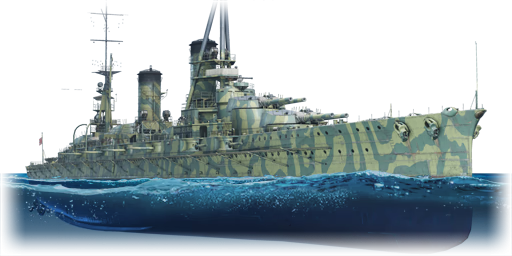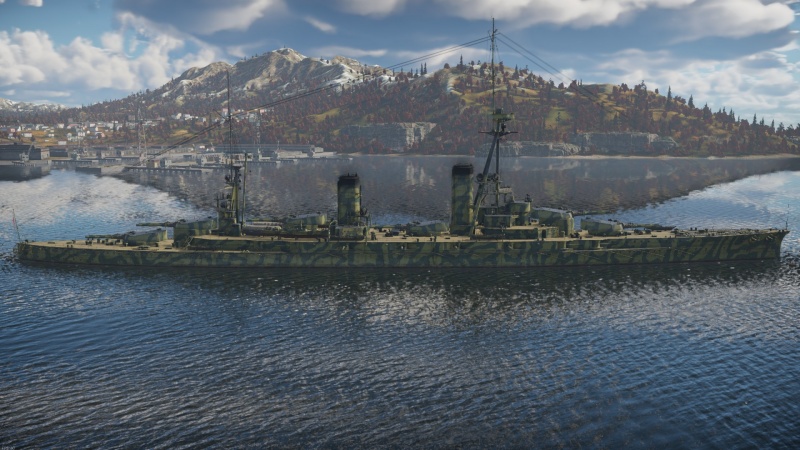IJN Yamashiro
Contents
Description
Yamashiro (山城) was the second ship of the Fusō-class battleships of the Imperial Japanese Navy, laid down in November 1913 and commissioned in March 1917. Throughout the interwar period, she underwent several modernisations, enhancing her armament, armour, and superstructure, including the enlargement of her distinctive pagoda-style mast. Despite these upgrades, Yamashiro was considered inferior to newer battleships, limiting her active deployment. During World War II, she served mainly as a training ship and participated in troop transport missions until October 1944, when she became the flagship of Vice Admiral Shōji Nishimura's Southern Force. In the Battle of Leyte Gulf, specifically the Battle of Surigao Strait, Yamashiro was sunk after an engagement where she was focused by multiple US battleships, marking the last battleship-versus-battleship combat in naval history.
The Fuso-class, IJN Yamashiro, 1920 is a premium gift rank Japanese battleship introduced in Update "Kings of Battle", with an additional pre-order which opened on 18 October 2023, granting a unique title - "Oni no Yamashiro" - and a unique Kyoto Prefecture flag. These bonuses have not been obtainable since 31 October 2023, when the update was released and pre-orders closed. Yamashiro has six turrets with twin 356 mm cannons, which can fire an extremely powerful broadside of twelve 356 mm shells, something that no other vessel can match in her BR. Similarly, her secondary casemate guns are able to deal with destroyers and light cruisers, although they suffer from very limited accuracy. Finally, her anti-air defences and torpedoes are mostly symbolic, offering limited effectiveness. Compared to her tech-tree equivalent, she trades a lower BR for worse survivability, less accurate secondaries, and a much worse anti-air/anti-boat capability.
General info
Survivability and armour
Talk about the vehicle's armour. Note the most well-defended and most vulnerable zones, e.g. the ammo magazine. Evaluate the composition of components and assemblies responsible for movement and manoeuvrability. Evaluate the survivability of the primary and secondary armaments separately. Don't forget to mention the size of the crew, which plays an important role in fleet mechanics. Save tips on preserving survivability for the "Usage in battles" section. If necessary, use a graphical template to show the most well-protected or most vulnerable points in the armour.
Mobility
Write about the ship's mobility. Evaluate its power and manoeuvrability, rudder rerouting speed, stopping speed at full tilt, with its maximum forward and reverse speed.
| Mobility Characteristics | |||
|---|---|---|---|
| Game Mode | Upgrade Status | Maximum Speed (km/h) | |
| Forward | Reverse | ||
| AB | |||
| Upgraded | 50 | 25 | |
| RB/SB | |||
| Upgraded | 43 | 22 | |
Modifications and economy
Armament
Primary armament
Provide information about the characteristics of the primary armament. Evaluate their efficacy in battle based on their reload speed, ballistics and the capacity of their shells. Add a link to the main article about the weapon: {{main|Weapon name (calibre)}}. Broadly describe the ammunition available for the primary armament, and provide recommendations on how to use it and which ammunition to choose.
| Penetration statistics | |||||||
|---|---|---|---|---|---|---|---|
| Ammunition | Type of warhead |
Penetration @ 0° Angle of Attack (mm) | |||||
| 1,000 m | 2,500 m | 5,000 m | 7,500 m | 10,000 m | 15,000 m | ||
| Ordinary SAP | SAPCBC | 301 | 280 | 248 | 222 | 199 | 168 |
| 3rd Year Type APC | APCBC | 607 | 564 | 500 | 447 | 402 | 338 |
| Shell details | ||||||||||||
|---|---|---|---|---|---|---|---|---|---|---|---|---|
| Ammunition | Type of warhead |
Velocity (m/s) |
Projectile mass (kg) |
Fuse delay (s) |
Fuse sensitivity (mm) |
Explosive mass (TNT equivalent) (kg) |
Ricochet | |||||
| 0% | 50% | 100% | ||||||||||
| Ordinary SAP | SAPCBC | 780 | 635.58 | 0.01 | 26 | 68.64 | 48° | 63° | 71° | |||
| 3rd Year Type APC | APCBC | 780 | 635.58 | 0.05 | 26 | 13.31 | 48° | 63° | 71° | |||
Secondary armament
Some ships are fitted with weapons of various calibres. Secondary armaments are defined as weapons chosen with the control Select secondary weapon. Evaluate the secondary armaments and give advice on how to use them. Describe the ammunition available for the secondary armament. Provide recommendations on how to use them and which ammunition to choose. Remember that any anti-air armament, even heavy calibre weapons, belong in the next section. If there is no secondary armament, remove this section.
| Penetration statistics | |||||||
|---|---|---|---|---|---|---|---|
| Ammunition | Type of warhead |
Penetration @ 0° Angle of Attack (mm) | |||||
| 1,000 m | 2,500 m | 5,000 m | 7,500 m | 10,000 m | 15,000 m | ||
| Type 0 HE | HE | 35 | 35 | 35 | 35 | 35 | 35 |
| Type 4 SAP | SAP | 81 | 68 | 52 | 40 | 34 | 34 |
| Shell details | ||||||||||||
|---|---|---|---|---|---|---|---|---|---|---|---|---|
| Ammunition | Type of warhead |
Velocity (m/s) |
Projectile mass (kg) |
Fuse delay (s) |
Fuse sensitivity (mm) |
Explosive mass (TNT equivalent) (kg) |
Ricochet | |||||
| 0% | 50% | 100% | ||||||||||
| Type 0 HE | HE | 850 | 45.26 | 0 | 0.1 | 3.17 | 79° | 80° | 81° | |||
| Type 4 SAP | SAP | 850 | 45.26 | 0.01 | 7 | 2.92 | 47° | 60° | 65° | |||
Anti-aircraft armament
An important part of the ship's armament responsible for air defence. Anti-aircraft armament is defined by the weapon chosen with the control Select anti-aircraft weapons. Talk about the ship's anti-air cannons and machine guns, the number of guns and their positions, their effective range, and about their overall effectiveness – including against surface targets. If there are no anti-aircraft armaments, remove this section.
Additional armament
Describe the available additional armaments of the ship: depth charges, mines, torpedoes. Talk about their positions, available ammunition and launch features such as dead zones of torpedoes. If there is no additional armament, remove this section.
Usage in battles
Describe the technique of using this ship, the characteristics of her use in a team and tips on strategy. Abstain from writing an entire guide – don't try to provide a single point of view, but give the reader food for thought. Talk about the most dangerous opponents for this vehicle and provide recommendations on fighting them. If necessary, note the specifics of playing with this vehicle in various modes (AB, RB, SB).
Pros and cons
Summarise and briefly evaluate the vehicle in terms of its characteristics and combat effectiveness. Mark its pros and cons in the bulleted list. Try not to use more than 6 points for each of the characteristics. Avoid using categorical definitions such as "bad", "good" and the like - use substitutions with softer forms such as "inadequate" and "effective".
Pros:
Cons:
History
Yamashiro was the second vessel of the Fusō-class battleships, laid down on 20 November 1913 at the Yokosuka Naval Arsenal and launched on 3 November 1915. Her construction was delayed due to budgetary constraints. During this period, her sister ship Fusō was completed and entered service. Criticisms of Fusō's design, particularly issues related to the protection scheme and the placement of rangefinders, prompted modifications to Yamashiro's design during her construction.
As a result of these alterations, Yamashiro differed significantly from Fusō despite starting as identical twins. The most noticeable difference was in the design of the superstructure: Yamashiro's bridge had a straighter, more forward-leaning appearance compared to Fusō's pagoda-style superstructure. Additionally, the orientation of the third turret was modified, with Yamashiro's turret facing aft while Fusō's faced forward, allowing for a better design of the internal machinery and ammunition-handling spaces. During the interwar period she served in various capacities, including as a training vessel, and underwent a number of refits, with the largest modernisation lasting from December 1930 to February 1935, including upgrades to her main, secondary, and anti-air guns, complete replacement of the machinery, adding torpedo bulges, and extending the length of the entire vessel by nearly 8 metres.
She took part in the beginning of the Second World War in the Pacific, as part of Battleship Division 2 during the attack on Pearl Harbor (Operation Z), but did not see combat. Following that, Yamashiro served largely as a training vessel during the later stages of the conflict. In 1942 she took part in the Battle of Midway (Operation Mi), but was kept away from combat. She continued her service as a training vessel and received a few minor refits during that period, most notably to the radars and fire control systems as well as increased anti-air complement. Finally, in October 1944 she became the flagship of Vice Admiral Shoji Nishimura's force during the Battle of Leyte Gulf (Operation Shō-1-Go). On 25 October 1944, Yamashiro participated in the Battle of Surigao Strait, where she was sunk by United States naval forces, marking one of the last battleship-versus-battleship engagements in history. The ship was lost with most of her crew, including Nishimura himself. In December 2017, the wreck of Yamashiro was discovered in the Surigao Strait by a research team led by Paul Allen.
Media
- Skins
See also
- HMS Iron Duke (Battleship sold in pre-order alongside the Yamashiro)
External links
- [Devblog] Battleships HMS Iron Duke and IJN Yamashiro!
- [Wikipedia] Japanese battleship Yamashiro
- [大日本帝国軍 主要兵器] 山城【扶桑型戦艦 二番艦】 Yamashiro【Fuso-class battleship Second】
- [Combined Fleet] IJN Battleship YAMASHIRO: Tabular Record of Movement
- [Naval Encyclopedia] Fuso class battleships (1915)
- [World War II Database] Battleship Yamashiro
- [The Dreadnought Project] Yamashiro (1915)
- [Navypedia] FUSO battleships (1915 - 1917)
| Yokosuka Naval Arsenal (横須賀海軍工廠) | |
|---|---|
| Destroyers (DD) | |
| Momi-class | IJN Momi |
| Light Cruisers (CL) | |
| Mogami-class | IJN Suzuya |
| Heavy Cruisers (CA) | |
| Myōkō-class | IJN Myoko |
| Battlecruisers (BC) | |
| Kurama-class | IJN Kurama |
| Amagi-class | IJN Amagi |
| Battleships (BB) | |
| Fusō-class | IJN Yamashiro |
| Nagato-class | IJN Mutsu |
| Tanks | Ka-Mi · Ka-Chi · Chi-Ha LG |
| See also | Yokosuka Naval Air Technical Arsenal |
| Japan battleships | |
|---|---|
| Kawachi-class | IJN Settsu |
| Fusō-class | IJN Fuso · IJN Yamashiro |
| Ise-class | IJN Ise · IJN Hyuga |
| Kongō-class | IJN Kongo · IJN Haruna |
| Nagato-class | IJN Mutsu |
| Japan premium ships | |
|---|---|
| Motor torpedo boats | Type T-14 (mod. 1) · Type T-51a |
| Motor gun boats | Type 4 (Mod 4) · PG 02 |
| Sub-chasers | Type K-8 No.13 |
| Frigates | Akebono |
| Destroyers | IJN Satsuki · IJN Nenohi · IJN Hayanami · IJN Kiyoshimo · IJN Yuudachi · JDS Yūgure (DD-184) |
| Light cruisers | IJN Yubari · IJN Mikuma |
| Heavy cruisers | IJN Myoko |
| Battleships | IJN Yamashiro |





